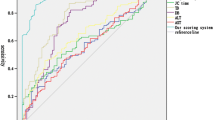Abstract
A retrospective analysis was performed of the records of 133 patients with extrahepatic biliary atresia (EHBA) who had undergone a Kasai portoenterostomy. The patients were divided into a non-transplantation group who survived but did not receive liver transplantation after the procedure and a failure group of those who died or received liver transplantation. A score was calculated that assessed nine factors, including laboratory values and complications. The data were assessed at the time complications occurred. The scores were analysed by a trend analysis to see if serial scores predicted the evolution of liver disease. A receiver operating characteristic (ROC) curve was plotted to assess the optimal cut-point for the scoring system. There were 98 patients in the non-transplantation group and 35 in the failure group. The latter group had significantly higher post-operative bilirubin (9.3±7.2 mg/dl versus 3.5±3.1 mg/dl), ALT (136±89 U/l versus 92±88 U/l), prothrombin time, and incidence of cirrhosis, ascites, oesophageal varices, portal hypertension, cholangitis and sepsis than the non-transplantation group ( P <0.05). A score of ≥8 had a high sensitivity (96.9%) and specificity (89.5%) for predicting the need for liver transplant. Conclusion:based on easily available clinical information, our scoring system can predict which patients with biliary atresia who have already undergone a Kasai procedure should be considered for liver transplantation.

Similar content being viewed by others
Abbreviations
- EHBA :
-
extrahepatic biliary atresia
- ROC :
-
receiver operating characteristic
References
Altman RP, Lilly JR, Greenfield J, Weinberg A, van Leeuwen K, Flanigan L (1997) A multiple risk factors analysis of the portoenterostomy (Kasai) procedure for biliary atresia. Twenty-five years of experience from two centers. Ann Surg 226: 348–355
Carceller A, Blanchard H, Alvarez F, St-Vil D, Bensoussan AL, Di Lorenzo M (2000) Past and future of biliary atresia. J Pediatr Surg 35: 717–720
Karrer FM, Price MR, Bensard DD, Sokol RJ, Narkewicz MR, Smith DJ, Lilly JR (1996) Long-term results with the Kasai operation for biliary atresia. Arch Surg 131: 493–496
Kasai M, Mochizuki I, Ohkohchi N, Chiba T, Ohi R (1989) Surgical limitation for biliary atresia: indication for liver transplantation. J Pediatr Surg 24: 851–854
Lipsett PA, Segev DL, Colombani PM (1997) Biliary atresia and biliary cysts. Baillieres Clin Gastroenterol 11: 619–641
Miyano T, Fujimoto T, Ohya T, Shimomura H (1993) Current concept of the treatment of biliary atresia. World J Surg 17: 332–336
Ohhama Y, Shinkai M, Fujita S, Nishi T, Yamamoto H (2000) Early predication of long-term survival and the timing of liver transplantation after the Kasai operation. J Pediatr Surg 35: 1031–1034
Ohi R, Chiba T, Mochizuki I (1988) Long term follow-up of patients with biliary atresia. Conference on mechanisms and management of pediatric hepatobiliary disease, Arlington, VA, 96
Okazaki T, Kobayashi H, Yamataka A, Lane GJ, Miyano T (1999) Long-term post-surgical outcome of biliary atresia. J Pediatr Surg 34: 312–315
Otte JB, de Ville de Goyet J, Reding R, Hausleithner V, Sokal E, Chardot C, Debande B (1994) Sequential treatment of biliary atresia with Kasai portoenterostomy and liver transplantation: a review. Hepatology 20: 41S–48S
Ryckman F, Fisher R, Pedersen S, Dittrich V, Heubi J, Farrell M, Balistreri W, Ziegler M (1993) Improved survival in biliary atresia in the present era of liver transplantation. J Pediatr Surg 28: 382–386
Ryckman FC, Alonso MH, Bucuvalas JC, Balistreri WF (1998) Biliary atresia: surgical management and treatment options as they relate to outcome. Liver Transplant Surg 4: S24–S33
Vacanti JP, Shamberger RC, Eraklis A, Lillehei CW (1990) The therapy of biliary combining the Kasai portoenterostomy with liver transplantation: a single center experience. J Pediatr Surg 25: 149–152
Wood RP, Langnas AN, Stratta RJ, Pillen TJ, Williams L, Lindsay S, Meiergerd D, Shaw BW Jr (1990) Optimal therapy for patients with biliary atresia: portoenterostomy versus primary transplantation. J Pediatr Surg 25: 153–162
Author information
Authors and Affiliations
Corresponding author
Rights and permissions
About this article
Cite this article
Jiang, CB., Lee, HC., Yeung, CY. et al. A scoring system to predict the need for liver transplantation for biliary atresia after Kasai portoenterostomy. Eur J Pediatr 162, 603–606 (2003). https://doi.org/10.1007/s00431-003-1268-x
Received:
Accepted:
Published:
Issue Date:
DOI: https://doi.org/10.1007/s00431-003-1268-x




